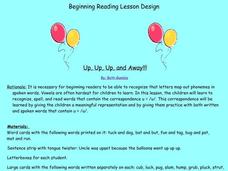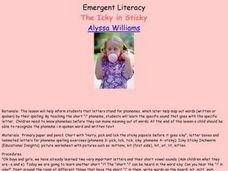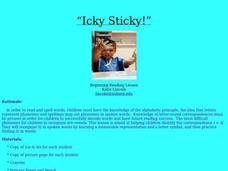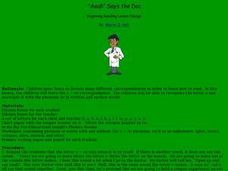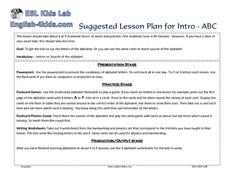Curated OER
Up, Up and Away
Students recognize the short vowel u in written and spoken language. Through matching and listening activities, they discriminate the vowel sound /u/ from other phonemes. Students identify the phoneme and letter in words and pictures.
Curated OER
What's Behind the Creaky Door?
First graders are introduced to the concept that letters stand for the mouth moves that we make when sounds are made. They practice making the /e/ sound and compare it to the sound a creaky door makes and then try saying the tongue...
Curated OER
Alphabetic Acting
Students recognize the short vowel a in written and spoken language. Through matching activities, they discriminate the short vowel /a/ from other vowel phonemes. Students associate the phoneme with its letter representation and identify...
Curated OER
The Icky in Sticky
Students study the /i/ sound by listening to it in words and a tongue twister which they later recite. Next, they practice writing the letter and making word using letterboxes. They listen to 'Icky Sticky Inchworm' while placing their...
Curated OER
Ugh!
First graders focus on the phoneme /u/. They make the sound and say "Ugh" and pronounce other words that contain the /u/ sound such as tub. They then repeat a tongue twister featuring the /u/ sound breaking the sound off each word and...
Curated OER
Icky Sticky
Students recognize the short vowel i in written and spoken language. Through matching and listening activities, they discriminate the vowel sound /i/ from other phonemes. Students identify the phoneme and letter in words and pictures.
Curated OER
Abigail Ant
Students recognize the short vowel a in written and spoken language. Through matching and listening activities, they discriminate the vowel sound /a/ from other phonemes. Students identify the phoneme and letter in words and pictures.
Curated OER
Uh??? I Don't Know
Students explore the short /u/ sound. They practice making the sound and use letterboxes to spell 'u' words. They recite tongue twisters and read with a partner, 'Fuzz and the Buzz.' They practice writing 'u' words and draw a circle...
Curated OER
What's Up Doc?
Students demonstrate the /o/ sound by opening up their mouth and saying, "Ahhhhh". They try saying a tongue twister that contains the /o/ phoneme; repeating it two times together. They then practice writing the letter /o/ so that it can...
Curated OER
Can You Open the Creaky Door?
Students recognize the short vowel e in written and spoken language. Through matching and listening activities, they discriminate the vowel sound /e/ from other phonemes. Students identify the phoneme and letter in words and pictures.
Curated OER
Olly Octopus
Pupils recognize the short vowel o in written and spoken language. Through matching and listening activities, they discriminate the vowel sound /o/ from other phonemes. Students associate the phoneme with its letter representation in...
Curated OER
/e/ It Must be Old
First graders discover that written language is a secret code that may be broken if they learn to move their mouths in different ways when they say different letters. They compare the sound a creaky door makes to the /e/ sound. They try...
Curated OER
The Slimy, Scaly, Slithering Snake
Students, through modeling, explore how to make the /s/ sound. They identify /s/ words and practice saying an /s/ tongue twister. They practice writing the letter 's'. They listen carefully to a story and hold up a snake puppet when...
Curated OER
Open Wide
First graders make the sound of /o/ relating it to the sound they make when the doctor asks them to open their mouth and say "ahhhh". They think of different words that contain the /o/ and identify it as it is used in a sentence and...
Curated OER
Pooh's Rumbling Tummy
Students recognize the short vowel u in written and spoken language. Through matching and listening activities, they discriminate the vowel sound /u/ from other phonemes. Students identify the phoneme and letter in words and pictures.
Curated OER
"Aaah" Says the Doc
Young scholars complete a variety of activities as they explore/review the letter 'o' as it makes the short /o/ sound. They recite short /o/ tongue twisters, practice writing the letter 'o', and listen to stories, identifying words with...
Curated OER
Champions Check
First graders identify consonant digraphs in written and spoken language. After a brief discussion of the combinations of /c/ and /h/ that comprise the /ch/ digraph, 1st graders practice identifying initial and final placement of the...
Curated OER
Tricky Nicky
Students recognize the short vowel i in written and spoken language. Through listening and matching activities, they discriminate the vowel sound /i/ from other phonemes. Students identify the phoneme and letter in words they decode with...
Curated OER
Let's Read and Read!
Students discover how to hold their mouths to form the /o/ sound and that it may be hidden in different words. They say /o/ and then repeat a tongue twister that contains many /o/ words and practice writing it on primary lined paper....
Curated OER
Crying Baby Sound
Students recognize the short vowel a in written and spoken language. Through matching and listening activities, they discriminate the vowel sound /a/ from other phonemes. Students identify the phoneme and letter in words from the story...
Curated OER
Beginning Sounds
Students sit in a circle and repeat the names and sounds of the first letter of their first names. Next, they trace their name once on the practice paper and then practice writing their name on the other lines. Then they observe the...
Curated OER
Shine Those Shades!
First graders observe as the /h/ sound is demonstrated and repeat it themselves. They practice saying a tongue twister using the /h/ sound stretching out the sound at the beginning of the words. They then take out primary paper and...
Curated OER
ABCs in English
Students name the letters of the alphabet. In this ESL lesson, the teacher introduces the letters of the alphabet or their sounds, then the class plays games to practice the letter names or sounds.
Curated OER
I Love to Eat Apples!
Students study the a=/a/ correspondence by first examining how they hold their mouths when biting into an apple. They practice the sound while reciting a tongue twister and making a gesture each time they hear the /a/. While looking at...


